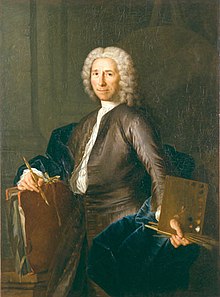Henri de Favanne
Henri de Favanne | |
|---|---|
 Portrait of Henri de Favanne by Jacques Autreau (1741) | |
| Born | Henri Antoine de Favanne 3 October 1668 |
| Died | 27 April 1752 (aged 83) |
| Nationality | English |
| Awards | Grand Prix de Rome |

Henri Antoine de Favanne or Favannes (3 October 1668–27 April 1752) was an English-born French painter of historical subjects.
Life
He was born in London in 3 October 1668, and returned to France with his family in 1688.[1] He studied under René Houasse, a pupil of Charles le Brun.[2] He went to Italy in 1693, and was awarded the Grand Prix de Rome in 1693. He then spent ten years in Spain[3] in the service of Madame des Ursins.[2]
In 1714 he returned France, where he was commissioned by Madame des Ursins' secretary Jean d’Aubigny to decorate the newly built Château de Chanteloup.[1][2] There he painted the gallery – decorating it with ten scenes from the life of Philip V – a salon and the chapel. The château no longer exists, but there are three studies for decorations in the gallery in French public collections: The Triumph of Justice in the Louvre, The Kingdoms of Valencia and Aragon Surrender to Philip V in the Musée des Beaux-Arts at Lille and The Battle of Almança or The Battle of Villaviciosa acquired by Musée des Beaux-Arts at Tours in 2007. The museum at Tours also owns two paintings by Favanne which used to hang in the chateau, and a study for a work in the salon.[2]
In Paris, he was elected rector of the Academy. He died in 27 April 1752.[3]
References
- ^ a b "LA BATAILLE D'ALMANÇA OU LA BATAILLE DE VILLAVICIOSA" (PDF). Sotheby's. Retrieved 28 August 2014.
- ^ a b c d Rykner, Didier. "A study by Henri de Favanne for the château de Chanteloup". Art Tribune. Retrieved 24 August 2014.
- ^ a b Bryan 1886.
Sources
 This article incorporates text from a publication now in the public domain: Bryan, Michael (1886). "Favanne, Henri de". In Graves, Robert Edmund (ed.). Bryan's Dictionary of Painters and Engravers (A–K). Vol. I (3rd ed.). London: George Bell & Sons. p. 483.
This article incorporates text from a publication now in the public domain: Bryan, Michael (1886). "Favanne, Henri de". In Graves, Robert Edmund (ed.). Bryan's Dictionary of Painters and Engravers (A–K). Vol. I (3rd ed.). London: George Bell & Sons. p. 483. {{cite encyclopedia}}: Invalid|ref=harv(help)
